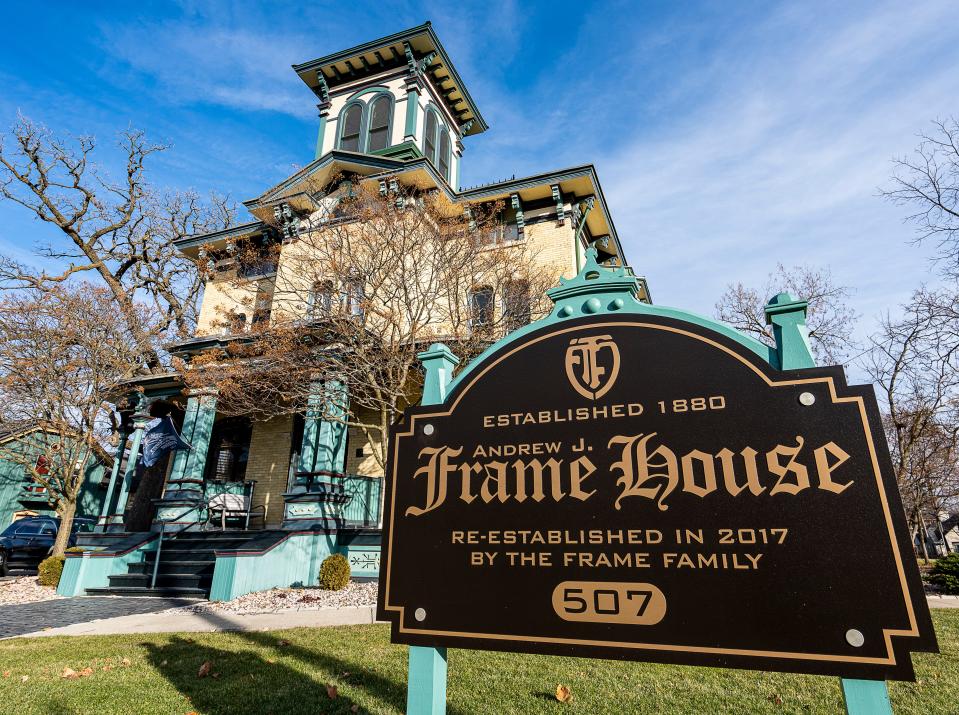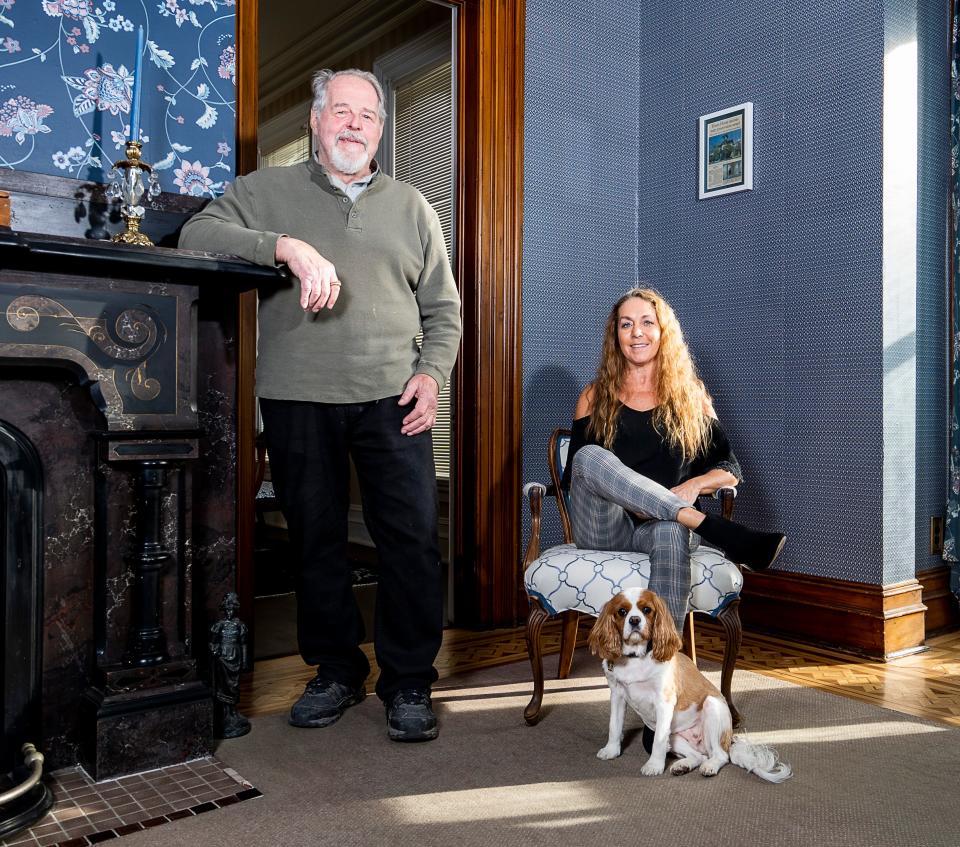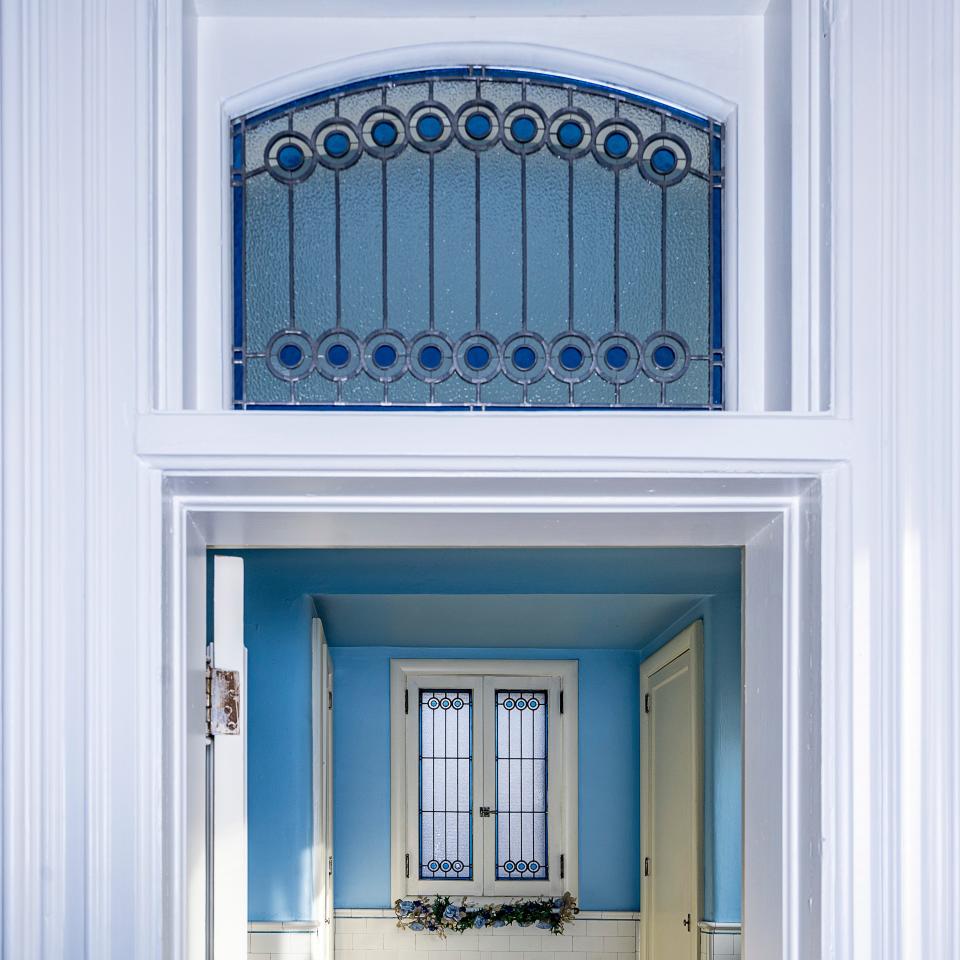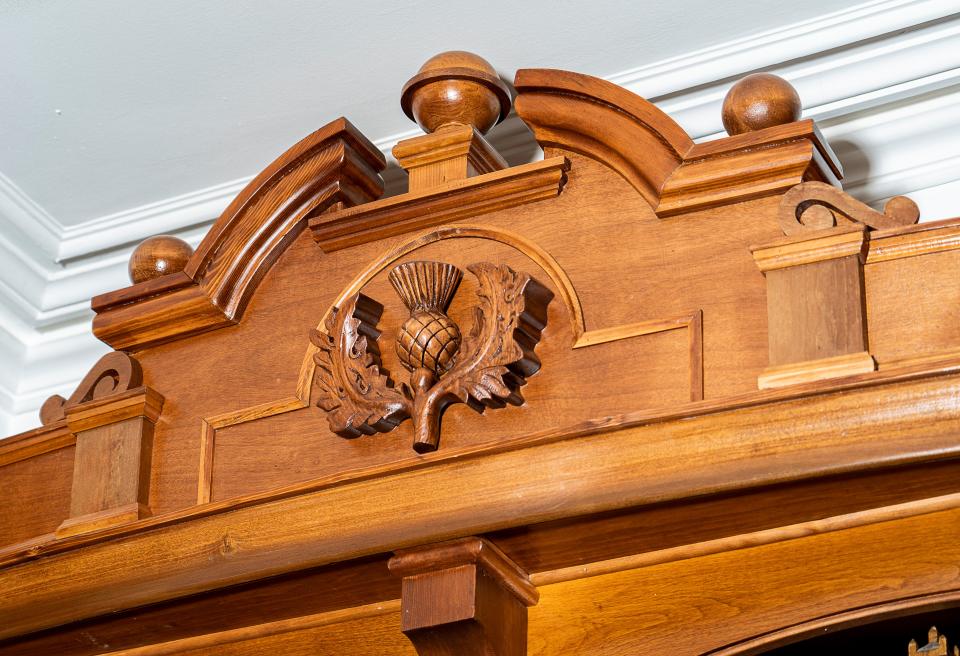Restoring historical homes is a passion for Ron Raasch of Two Hands Restoration
When Ron Raasch works on restoring old structures, he focuses on doing work both he and the homeowners will be proud of. But, he admits, his mind often wanders to thoughts of the history of the buildings and those who worked there before him.
“History is a big driving force for me. I like to hear the stories about these old houses. I often do research on the houses I work on. I do it for myself but also for the homeowners," he said.
“I’ve found things in the walls of buildings many times. It’s so wonderful to find these things. I found shoes from a whole family in one wall, and I found part of someone’s lunch, once. I found bones and an old bottle.”
At a Wauwatosa mansion he once found a time capsule, then left one there himself.
Retaining the history of a building, both manually and mentally, is clearly a passion for Raasch, who is the owner of Two Hands Restoration, (twohandsrestoration.com) a Greendale firm that does design, consulting, construction and preservation of historically significant buildings — from log cabins to sprawling mansions.
It’s a business he started 32 years ago, after learning his craft mainly from his father, who he said "did all manners of woodworking projects."
“I’ve always been fascinated by the process of combining design and function. I learned the value of things well made," he said.
Raasch said his dad learned his trade at Milwaukee's Boys Technical and Trade School (now Bradley Tech High School), then later was a carpenter at Allen-Bradley.
“At his job people started noticing his unique talents and he was called upon to do side jobs for the higher ups at their homes, and I often followed along," he said. “I enjoyed watching the interaction between the people and I enjoyed watching the work my dad was doing. I can remember holding the nails for him. I would put all the nails heads up and then I would hand them to my dad and then grab more.
“Then he might say, ‘Saw three more board like this.’ I learned how to measure accurately and learned what the next steps were in the projects he was doing. While he worked, he was always explaining what he was doing.
“That got me interested in construction and remodeling, but I also took note of things that were more stylized — things that had more of an aesthetic. I appreciated the intricacies involved in old houses,” he said.
Raasch took his first woodworking class at the former Fritsche Middle School. By then he already knew the basics and while others in his class were told to make simple projects such as bookends, his teacher told him to make whatever he wanted.
“I made a coffee table. It was in a mid-century modern style and it had simple curving lines. I made it out of cherry wood. It was an easy grade for me and I enjoyed being in the workshop. The teacher told me I was already very competent and I told him that this kind of work was my father’s livelihood.”
That was the only class he ever took in pursuing his career.
“My apprenticeship was literally just following my father around,” he said.
After high school Raasch worked at Falk Corporation where he met others he learned from.
“I worked at a loading shed with 12-by-12 timbers. We were building very customized-shaped cradles and skids for motor drives and gears. This was heavy-duty work and the pieces were very fitted into each other like pieces would fit into a log cabin," he said. “There were a couple of older European gents I worked with and they could do anything with an ax. That’s when I thought, ‘I have to learn how to build or restore a log cabin.’”
He later worked for builders who made modern houses, at Discovery World where he made exhibits, then at a restoration company where he headed its design and woodworking department.
“I found that I liked working directly with the homeowners. So after that company closed I felt it was time to go on my own,” he said.
Today he works mainly on buildings built between the 1830s and the 1930s. But he admits he is always open to an interesting project.
“If someone called and said they had a 1950s building with unusual features, I might consider it. But for the most part I don’t work on McMansions of the '90s or on more contemporary homes,” he said.
So that his work matches or historically complements the original structures, he uses both old and new tools and old lumber.
“I do use what is most appropriate to the project," he said. "When it comes to things like carving, you have to use old-style tools. For example, chisels for carving come in different orientations that aren’t just flat. You need different sizes and different curves. And when doing fine work, instead of using a hammer you would use a mallet, because a hammer could break the wood.
“Some jobs require using more labor-intensive hand tools — maybe something like a coping saw. Sometimes those old tools are handier or more efficient than using electric tools.”
Work on a log home or a barn might require the use of an adz, he said.
“It’s like an ax but with the cutting edge going perpendicular to the handle, and it’s also curved. You would use the adz to make a log from round to square, and it leaves a pattern of chipping. You are chipping the round part of a log until you have a flat surface on four sides.”
Old molding planes would be used when working on old mullioned glass windows to get the exact contour of the dividing pieces in the windows.
He said it’s also important to use old-growth wood when trying to replicate historical features.
“You have to use old-growth wood whenever possible to match existing wood. It has capabilities for longevity and it’s also more resistant to bugs and weather as it has a very tight grain," he said. “And when you find clear stock, which is wood with no knots in it, you buy it and keep it until it’s called for. Sometimes people will give it to me. They might say they want to clear out their garage.”
Raasch said while he has no special training or licensure to work in historical restoration, he does research on the properties he works on in order to make changes look like they are original to the building.
“Generally I know what to do at this point, but (for information) you can look at Sandborn maps at the local historical societies. Sandborn maps are insurance maps that existed before building codes. You can also look for old photos.”
One of his favorite projects to date is the Dr. Fisk Holbrook Day House, an 1874 high Victorian gothic revival house in Wauwatosa that is on the National and State registers of historic places.
“In 1988 I did an extensive exterior and structural restoration to make the house waterproof and to replicate exterior detailing. And in 1990 I designed and built a new front porch” in the space where a porch had once been, he said.
To build a porch that would look like it was original to the house, he looked to an old photo and a bracket on a bay window nearby.
“I got the photo from the homeowner. They had done some research and they found a glass plate negative from when the house was built. It was a picture of the front of the house that showed me that the bracket on the nearby bay window was used on the porch. So I could use the existing bracket as a guide, and as a unit of measure to gauge the size of the porch.”
He also worked as a consultant when the homeowners had the home gutted and restored.
“It was the finest home I’ve ever worked in, but it was a wreck. It had live and dead animals in it, and it had been made into a three-family residence. Someone had added walls, staircases and bathrooms, and there was a lot of deterioration.”
Another project Raasch enjoyed was the coach house at the Kneeland-Walker House in Wauwatosa. There, he built an interior staircase using materials found on-site and did restoration work on the building's exterior. The Kneeland-Walker House is on the National and State registers of historic places.
Another memorable project was a large building with a storefront and second-floor residences on Milwaukee's east side that had been covered with asphalt brick siding for 50 years.
“There I replaced much of the wood siding and strap-work — which are the vertical and horizontal boards that form an aesthetic to the building — and I carved two decorative inset panels. I also added period doors from another building," Raasch said. “Then I devised a five color scheme to paint the exterior in the style of a painted lady that was neither cute or garish.”
Current projects include work on two buildings on the National and State historic registers, the Matthew Keenan House on Jefferson Street and the Andrew Frame House in Waukesha.

The Keenen House, built in 1860, was designed by Milwaukee architect Edward Townsend Mix. Raasch described it as a brick Italianate double house with two entryways and six bays or quadrants and said he's restoring the front porch, including the porch's balustrades.
At the Frame House, an 1879 Cream City brick Italianate also designed by Townsend Mix, work has been done inside and outside, and started soon after Karen Frame, the current owner, purchased it in 2017. The house was built by her great-great-grandfather, Waukesha philanthropist Andrew Jay Frame.

One of the major projects outside was re-creating a rear porch that had been removed. To be sure the porch fit the style of the house, Raasch looked to the design of the front porch. He also built new decorative storm and screen doors and added newel posts with rounded tops that fit the style of the house.
Inside he added a transom window over a first floor bathroom door, filling the opening with a piece of decorative stained glass he designed. The glass complements an exterior stained glass window already in the bathroom.

In an area at the front of the house that was originally a parlor but was later used as an office, he changed a bookcase that had been added by attorneys who worked there after members of the Frame family sold the building and it was zoned commercial.
“It was something Karen knew was not original. It was literally two boxes above four doors. There wasn’t even a quarter round on top. It had no sense of style. It was simply a functional bookcase for the attorneys who occupied the house for decades," Raasch said. “I asked her to consider letting me help the bookcase belong to the house. She basically said, 'OK, I know you will do a nice job.’”
To create a design for the top of the bookcase, he looked to her family history for inspiration. He ended up using artwork found on the cornice of the former Waukesha National Bank in downtown Waukesha that her great-great-grandfather built.
“I copied part of the cornice that was above the entryway, but I also added a thistle because the Frame family emigrated from Scotland and a thistle is an emblem of Scotland,” he said.

Another project was to turn a former pass-through between the home's kitchen and dining room into a display area for a collection of antique firearms and family photos.
“The suggestion from Karen was for me to ‘put the firearms on the wall someplace.’ They had been lying on the floor. ... I said, let me sleep on it. The former pass-through was just deep enough to allow me to make something more playful and to depict the family history.”
He built a display where he mounted the firearms, and he also had historic photographs enlarged and built decorative frames for them, carved a garland of flowers at the top of the display, and added doors.
Karen Frame called Raasch “a detailed craftsman” and said he has been helping her fine-tune her home since she bought it.
“Ron is fantastic with details and bringing the things that looked real basic from the '70s to life,” she said.
After Andrew Jay Frame died, she said various members of her family lived in the house and she remembers how grand it was.
“I remember being there as a child when my aunt, Mable Frame, lived there. Then later it wasn’t in the family for a few years, and I always wanted to buy it back.”
She said when she bought the house the front half of the first floor was being used as offices by attorneys, but the two upper levels were residential.
Today, she uses the commercial space as a family museum of sorts, and there are residential units on the second and third floors. She said she currently rents the units to relatives, but she hopes to live there one day.
In addition to work done by Raasch she also had a new kitchen added as the original kitchen had been removed by the previous owners. She also remodeled the first floor bathroom, and on the second floor she updated a guest bathroom and added a primary suite with a bathroom.
Her biggest project was in 2019 when she had the home's original belvedere replicated. She said the space, at the very top of the building, had been taken down in the '50s or '60s after it had fallen into disrepair.
She had it rebuilt on-site, then two cranes hoisted it up and it was bolted on to the existing structure.
Raasch said he believes these kinds of restoration projects are important because the kind of work done years ago is a lost art.
“It’s something that is less and less available. There are fewer and fewer people practicing these skills," he said. “It’s also environmentally sound to maintain things that are already built versus building something new. It’s a bigger carbon impact, to build something new versus to restore or maintain a structure.”
He added that while so many wonderful historical buildings were lost when the freeway system was built in the Milwaukee area, there is still “an enormous amount of old housing stock here on the east side, in the Bay View neighborhood, Waukesha” and other areas in southeastern Wisconsin.
Raasch recently answered a few questions about his background and his business.
What is it about historic homes you love so much?
The sense of understanding a developing community and how people lived at whatever level they could afford. And all the building techniques. Things dramatically changed in building materials, techniques and aesthetics after World War II. Then everything shifted. It was the era of the ranch home.
What's the oldest building you’ve ever worked on?
An 1830s log cabin in the Town of Erin.
Any other interesting finds on projects?
At a building on Brady Street I found an old radio transmitter in the attic that no one had seen in the last 40 years. It was from the '30s. It was probably used by a hobbyist and was very elaborate.
What are the oldest tools you have?
I have some marking tools and calipers that are quite old. I have some handsaws that are unique because of the number of teeth they have or the way the teeth are set. My father would sharpen his own saw blades and I still sharpen some of mine by hand. Nowadays most people throw them away. I have some of my dad’s old tools and some of the machinery he brought after he graduated from Boys Tech.
Do you still have the coffee table you first made?
No. But I have a couple of little tables my dad made when he was at Boys Tech. They are little walnut side tables.
Has there ever been renewed interest in this kind of work?
When the PBS Program "This Old House" came out in the late '70s there was a rise in awareness, but that’s fallen off. There is a shortage of young people entering all trades in general. Therefore the skills for older more unique rebuilds are harder to find. This has me considering more consulting and teaching as time goes on.
Do you have to follow certain regulations when restoring historical structures?
Sometimes you have to set up a meeting and talk to historic preservation organizations or other bodies that have a say on the house. If you want to get the tax credits, you have to go along with what they say you can do. You say, ‘This is what we propose to do.’ But this is mostly about the exterior of the house and what the public sees.
Any more projects planned at the Frame house?
No. Just maintenance work. That’s always required when you have an old house.
This article originally appeared on Milwaukee Journal Sentinel: Restoring historical homes is a passion for Two Hands Restoration's Ron Raasch

